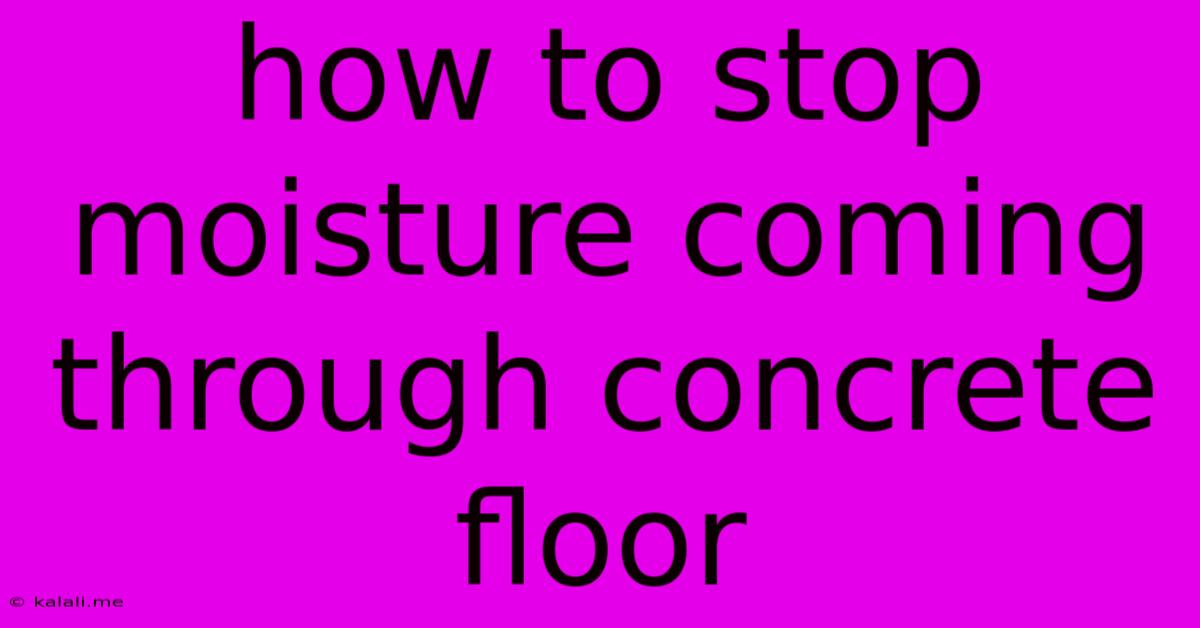How To Stop Moisture Coming Through Concrete Floor
Kalali
May 21, 2025 · 3 min read

Table of Contents
How to Stop Moisture Coming Through a Concrete Floor: A Comprehensive Guide
Dampness creeping up from your concrete floor? It's a common problem, leading to musty smells, mold growth, and damage to your flooring. This guide provides practical solutions to effectively tackle rising damp in concrete floors, improving your home's comfort and longevity. We'll explore various methods, from simple DIY fixes to more involved professional interventions.
Understanding the Source of Moisture
Before tackling the problem, identifying the source of moisture is crucial. Several factors can contribute to damp concrete floors, including:
- Ground water: High water tables can push moisture upwards through the concrete.
- Cracks in the concrete slab: These allow water to penetrate directly into the floor.
- Poor or inadequate damp proof membrane (DPM): A missing or faulty DPM is a major culprit.
- Leaking pipes: Hidden leaks can saturate the ground beneath the floor.
- Condensation: In poorly ventilated spaces, moisture in the air can condense on the cold concrete surface.
Effective Solutions to Tackle Damp Concrete Floors
The best solution depends on the source and severity of the dampness. Here's a breakdown of effective strategies:
1. Improving Ventilation
Good air circulation is key to preventing condensation. Ensure adequate ventilation in the affected area by:
- Opening windows regularly: This allows air to circulate and reduce moisture build-up.
- Using exhaust fans: These are especially helpful in bathrooms and kitchens.
- Installing dehumidifiers: These appliances actively remove moisture from the air.
2. Addressing Cracks in the Concrete
Even small cracks can compromise the floor's integrity and allow moisture penetration. Repairing them is crucial:
- Cleaning the cracks: Thoroughly clean the cracks to remove any debris.
- Filling the cracks: Use a suitable epoxy resin or concrete patching compound to fill the gaps completely.
- Sealing the repaired area: Apply a waterproof sealant to prevent future moisture penetration.
3. Applying a Damp Proof Membrane (DPM)
If the problem is significant, installing a DPM might be necessary. This involves:
- Removing existing flooring: This provides access to the concrete slab.
- Preparing the concrete surface: Ensure it's clean, dry, and level.
- Applying the DPM: Use a high-quality DPM, such as a plastic sheeting or a liquid membrane, and follow the manufacturer's instructions carefully.
- Installing new flooring: This protects the DPM and completes the moisture barrier.
4. Professional Solutions for Severe Cases
For severe cases of rising damp, consider professional intervention:
- Tanking: This involves applying a specialized waterproof coating to the walls and floor of the affected area.
- Electro-osmosis: This method uses electrical currents to repel moisture away from the concrete.
- Underfloor heating: While primarily for heating, underfloor heating can also help to dry out damp concrete floors by gently warming the slab.
5. Using Moisture-Resistant Materials
When choosing new flooring, opt for materials that are resistant to moisture damage:
- Vinyl: A popular and affordable option with excellent moisture resistance.
- Laminate: While not as waterproof as vinyl, many laminate floors offer good moisture resistance.
- Porcelain and ceramic tiles: Excellent choices for bathrooms and kitchens due to their high moisture resistance.
Maintaining a Dry Concrete Floor
Preventing moisture problems is as important as solving them. Regular maintenance helps keep your concrete floor dry:
- Regularly inspect your floor for cracks or signs of dampness.
- Ensure proper ventilation in the affected areas.
- Use dehumidifiers, especially during humid seasons.
- Address leaks promptly.
By carefully considering these solutions and implementing the appropriate preventative measures, you can effectively combat moisture in your concrete floor, creating a healthier and more comfortable living environment. Remember, for severe cases, consulting a professional is always recommended.
Latest Posts
Latest Posts
-
Can My Interlock Concrete Block Follow The Existing Elevation
May 23, 2025
-
Photoshop Remove Background Based On Color
May 23, 2025
-
Cameron Coleman Home Lander Floater In Bathroom Scene
May 23, 2025
-
I Was Told I Am Giving Adhan Wrong
May 23, 2025
-
What Does 2nf Mean On Multimeter When Measure Capacitance
May 23, 2025
Related Post
Thank you for visiting our website which covers about How To Stop Moisture Coming Through Concrete Floor . We hope the information provided has been useful to you. Feel free to contact us if you have any questions or need further assistance. See you next time and don't miss to bookmark.